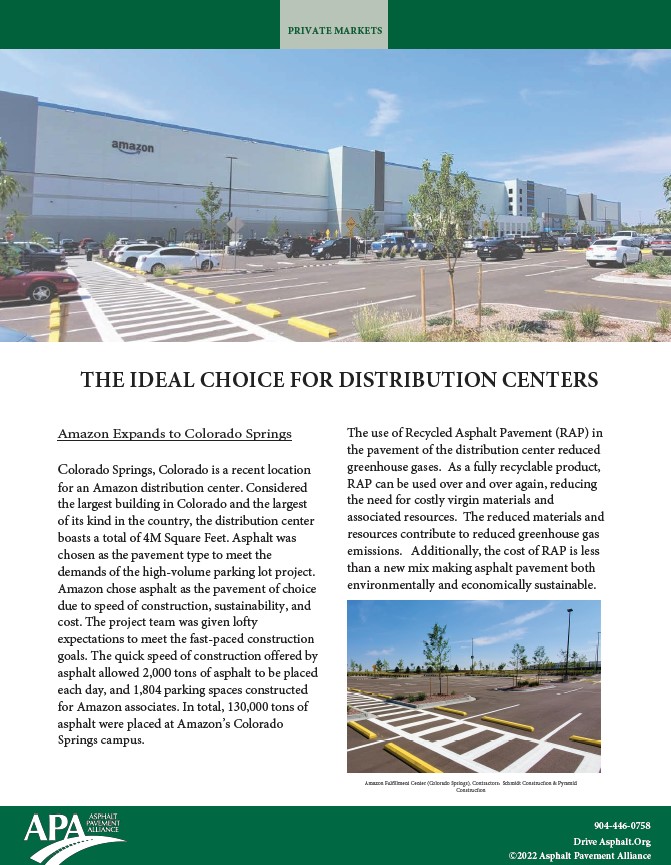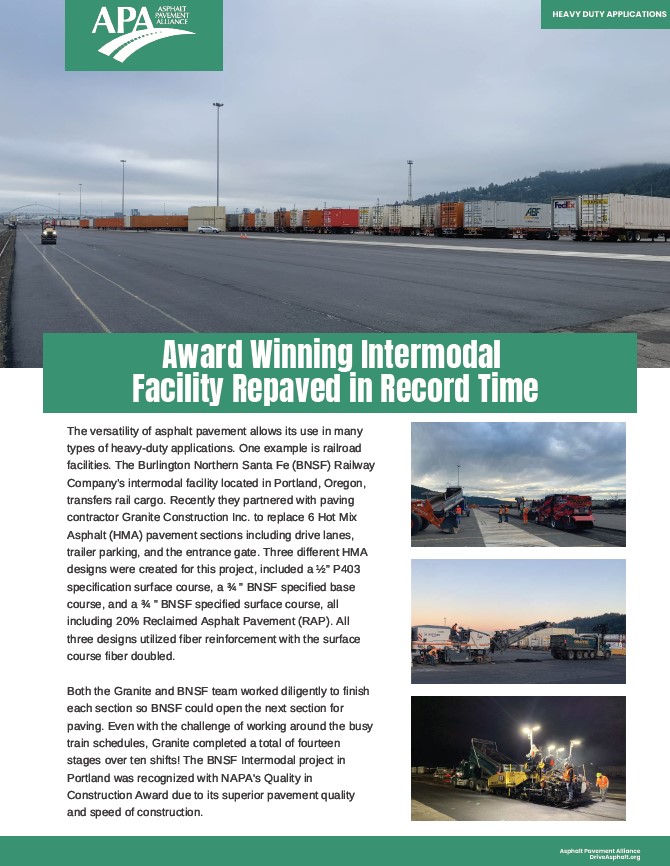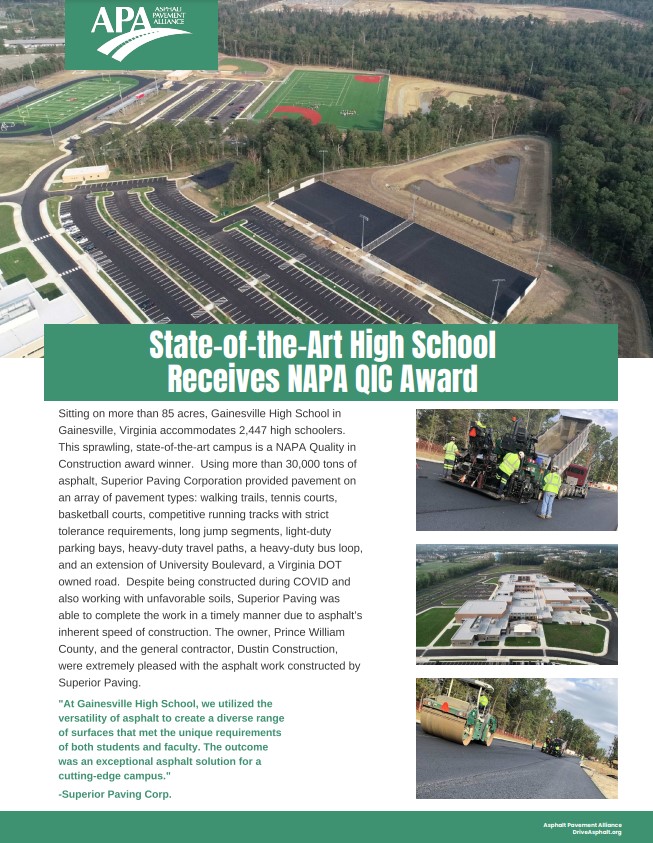FL Commercial & Industrial Parking Lot Training Open for Registration!
The Asphalt Pavement Alliance is offering Commercial and Industrial Parking Lot Training in Jacksonville, FL, on January 22-23, 2020.
The Asphalt Pavement Alliance is offering Commercial and Industrial Parking Lot Training in Jacksonville, FL, on January 22-23, 2020.
If you will be in the Kansas City area on February 19, 2020, you don't want to miss this FREE Asset Management Training: How to Drive Value Out of Your Parking Facilities. Presented by Superior Bowen, this traning will cover: Property Investment Strategy; How to Care for Your Parking Lot; How to Rehabilitate Your Parking Lot; How to Design From the Ground Up; and How to Build It.
In today’s world, being efficient and effective with resources is the name of the game to keep your customers and tenants returning year after year. Join us for this comprehensive educational seminar related to the unique requirements of your commercial and industrial parking lot installations. From construction to maintenance, materials to proper pavement design, learn what is required for keeping your facility in tip-top shape. The Asphalt Pavement Alliance is offering Commercial and Industrial Parking Lot Training in Spokane, WA, on October 29, 2019, and Seattle, WA, on October 30, 2019.
In today’s world, being efficient and effective with resources is the name of the game to keep your customers and tenants returning year after year. Join us for this comprehensive tng and education seminar related to the unique requirements of your commercial and industrial parking lot installations. From construction to maintenance, materials to proper pavement design, learn what is required for keeping your facility in tip-top shape April 10, 2019 8: 00 AM Registration 8: 30 - 4: 30 Training How to Build How to Maintain 5: 00 - 7: 00 PM Tour and Reception Dinner, transportation, and beverages included with registration. We will tour Fred Weber, Inc., near our training location.
When the storm of the century deluged west central Oregon last winter causing millions of dollars of flood damage to homes, businesses and infrastructure, one area that was conspicuously untouched was a high-profile environmental community with a unique stormwater control system.
www.AsphaltFACTS.com Launched to Raise Awareness of the Benefits of Smooth, Economical Asphalt Pavements
_Cover.jpg)
This checklist is designed to help the onsite inspector or owner’s representative identify key aspects of the process and understand best practices known to produce a quality pavement project.

Colorado Springs, Colorado is a recent location for an Amazon distribution center. Considered the largest building in Colorado and the largest of its kind in the country, the distribution center boasts a total of 4M Square Feet. Asphalt was chosen as the pavement type to meet the demands of the high-volume parking lot project. Amazon chose asphalt as the pavement of choice due to speed of construction, sustainability, and cost. The project team was given lofty expectations to meet the fast-paced construction goals. The quick speed of construction offered by asphalt allowed 2,000 tons of asphalt to be placed each day, and 1,804 parking spaces constructed for Amazon associates. In total, 130,000 tons of asphalt were placed at Amazon’s Colorado Springs campus.

The versatility of asphalt pavement allows its use in many types of heavy-duty applications. One example is railroad facilities. The Burlington Northern Santa Fe (BNSF) Railway Company’s intermodal facility located in Portland, Oregon, transfers rail cargo. Recently they partnered with paving contractor Granite Construction Inc. to replace 6 Hot Mix Asphalt (HMA) pavement sections including drive lanes, trailer parking, and the entrance gate.

Using more than 30,000 tons of asphalt, Superior Paving Corporation provided pavement on an array of pavement types: walking trails, tennis courts, basketball courts, competitive running tracks with strict tolerance requirements, long jump segments, light-duty parking bays, heavy-duty travel paths, a heavy-duty bus loop, and an extension of University Boulevard, a Virginia DOT owned road.
Parking lots are the gateway to which all employees, customers, and visitors view upon arrival. As a first impression, it's important to welcome pedestrians with a well-maintained, smooth parking lot. Asphalt parking lots are the superior material of choice for parking lots due to their speed of construction, sustainability, and cost. When designing an asphalt parking lot important considerations are: traffic, subgrade, and drainage.
Porous asphalt pavements are designed for dual duty: they provide pavements for parking and roads and also serve as stormwater storage and infiltration systems. They are in demand because they offer site planners and public works officials the opportunity to manage stormwater in an environmentally friendly way. With the proper design and installation, porous asphalt structures can offer cost-effective, attractive parking lots with a long life span (while also providing stormwater management systems that promote infiltration), improve water quality, recharge groundwater, and keep peale and total volume of flow at or below pre-development values.
Whether at a business, a shopping center, a school, house of worship, recreation area,or apartment building, a parking lot is one of the first things a person sees when arriving at their destination. First impressions matter, and a poorly constructed or maintained lot can reflect negatively on an establishment.
PAVEXpress is a web-based empirical pavement design tool that provides a free easy-to-use way to design technically sound pavement structures. It follows the AASHTO 93 design guide and the AASHTO 98 supplement for rigid pavements, and it makes it easy to either use AASHTO-recommended defaults or customize the data inputs.
In 2013, the City of Burnsville replaced a 12,000-square-foot section of parking lot with porous asphalt. This surface is similar to standard asphalt, except that the smaller sand particles are left out to create voids in the pavement. This allows rainwater and storm melt to run THROUGH the surface into the ground, rather than running into storm drains.